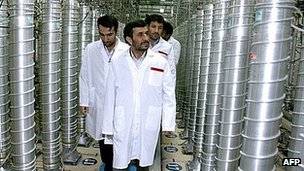
The highly anticipated report released today consists of two parts: a main body about implementation of safeguards and UN resolutions, and an annex, “Possible Military Dimensions to Iran’s Nuclear Program.” It is the annex that’s getting all the attention in the press, and rightly so, inasmuch as it is surely the most trenchant and alarming IAEA reporting about Iran since the March and November 2003 reports that first focused world attention on Iranian nuclear activities.
Those reports detailed a multi-decade pattern of NPT treaty violations by Iran that were without precedent in the agency’s history. They led to aggressive diplomatic action by the frontline European countries (France, the UK and Germany), journalistic exposes (including one in the New York Times magazine and one in IEEE Spectrum, both in June 2004), escalating diplomatic activity by the United States, UN resolutions, and finally UN sanctions, in which China and Russia joined.
The main body of the report, if in a sense a routine update on those matters, is itself not trivial. Essentially it says that though Iran has continued to comply with reporting requirements in a narrow sense and has not diverted any nuclear material from civil to military applications, it remains radically out of compliance with safeguards requirements and international resolutions in a broader sense. Iran resists many IAEA requests for information about its uranium-enrichment and heavy-water production programs, and it has not implemented the Additional Protocol it signed–a type of agreement giving the IAEA wider inspection privileges, which it started to insist on after Iraq’s secret nuclear weapons program came to light in the early 1990s. For these reasons, the IAEA Director General “urges Iran” to implement the Additional Protocol, suspend uranium enrichment and heavy-water activties pending restoration of international confidence, and address the agency’s concerns about “possible military dimensions to Iran’s nuclear program.”
The annex to the report spells out those concerns in great detail, relying heavily on a thousand-word intelligence document–the “alleged studies documentation”–provided by one member state, and much corroborating evidence provided by some ten other governments and obtained from other sources. The items that have received by far the most mention in the press, as well as here, have been a steel cyinder Iran is believed to have built to test the configuration of explosives for an implosion device, and the services provided by an expatriate Soviet weapons scientist. But there is a great deal more than that.
The annex documents that in the early part of the last decade, Iran had a well-organized program to design and develop components for a miniaturized implosion bomb that would be deliverable on its Shahab 3 medium-range missie. That program evidently included studies on how to convert uranium hexafluoride obtained from enrichment plants into uranium metal for a bomb; a so-called “green salt” project that was part of a larger program to obtain an autonomous source of uranium feedstock for a secret and unsafeguarded uranium enrichment plant; implosion-oriented explosives testing; development of a neutron initiator, a key component needed to trigger an implosion bomb; and iterative redesign of a Shahab 3 missile reentry vehicle to accommodate a nuclear warhead.
In 2003-04, after Iran’s secret uranium enrichment and heavy-water production activities came to light, the country not only came under intense diplomatic pressure but also had good reason to fear preemptive mliitary attack. Under those circumstances, it terminated that comprehensive nuclear weapon development program, known as the AMAD plan. It not only closed the main facility in which work had been done but physically obliterated all evidence of the work and reassigned the program’s leader, Mohsen Fakrisadeh.
However, as paragraph 23 of the Annex goes on to say, “The agency has information from member states which indicates that some activities previously carried out under the AMAD Plan were resumed later, and that Mr. Fakrisadeh retained the principal organizational role. . . .”
In other words, if this is not reading too much between the lines, it appears that Iran decided upon coming under heavy pressure in 2003-04 to terminate elements of the program that had neared completion and to disperse and hide the rest, while keeping overall management in the hands of Fakrisadeh. Though all of this may have been known to intelligence insiders in key member states, it certainly was not known to the general public or, for that matter, to many independent analysts who have been following Iran closely.
This much seems evident: Iran’s leadership has been not just vaguely interested in designing and building a deliverable nuclear weapon once it has the material to do so; it has been intently interested in doing so, and already eight years ago had made substantial progress in that direction. Although it is still quite some distance from being in a position to build a bomb, it is undoubtedly much closer now than it was in 2003-04, when it had to start going underground in every sense.